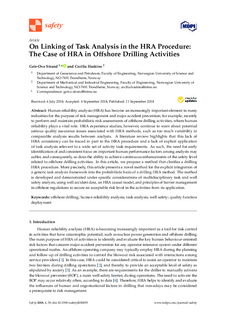| dc.contributor.author | Strand, Geir Ove | |
| dc.contributor.author | Haskins, Cecilia | |
| dc.date.accessioned | 2019-09-03T13:20:16Z | |
| dc.date.available | 2019-09-03T13:20:16Z | |
| dc.date.created | 2018-09-11T14:17:49Z | |
| dc.date.issued | 2018 | |
| dc.identifier.citation | Safety. 2018, 4 . | nb_NO |
| dc.identifier.issn | 2313-576X | |
| dc.identifier.uri | http://hdl.handle.net/11250/2612309 | |
| dc.description.abstract | Human reliability analysis (HRA) has become an increasingly important element in many industries for the purpose of risk management and major accident prevention; for example, recently to perform and maintain probabilistic risk assessments of offshore drilling activities, where human reliability plays a vital role. HRA experience studies, however, continue to warn about potential serious quality assurance issues associated with HRA methods, such as too much variability in comparable analysis results between analysts. A literature review highlights that this lack of HRA consistency can be traced in part to the HRA procedure and a lack of explicit application of task analysis relevant to a wide set of activity task requirements. As such, the need for early identification of and consistent focus on important human performance factors among analysts may suffer, and consequently, so does the ability to achieve continuous enhancements of the safety level related to offshore drilling activities. In this article, we propose a method that clarifies a drilling HRA procedure. More precisely, this article presents a novel method for the explicit integration of a generic task analysis framework into the probabilistic basis of a drilling HRA method. The method is developed and demonstrated under specific considerations of multidisciplinary task and well safety analysis, using well accident data, an HRA causal model, and principles of barrier management in offshore regulations to secure an acceptable risk level in the activities from its application. | nb_NO |
| dc.language.iso | eng | nb_NO |
| dc.publisher | MDPI | nb_NO |
| dc.rights | Navngivelse 4.0 Internasjonal | * |
| dc.rights.uri | http://creativecommons.org/licenses/by/4.0/deed.no | * |
| dc.title | On Linking of Task Analysis in the HRA Procedure: The Case of HRA in Offshore Drilling Activities | nb_NO |
| dc.type | Journal article | nb_NO |
| dc.type | Peer reviewed | nb_NO |
| dc.description.version | publishedVersion | nb_NO |
| dc.source.pagenumber | 20 | nb_NO |
| dc.source.volume | 4 | nb_NO |
| dc.source.journal | Safety | nb_NO |
| dc.identifier.doi | 10.3390/safety4030039 | |
| dc.identifier.cristin | 1608554 | |
| dc.description.localcode | © 2018 by the authors. Licensee MDPI, Basel, Switzerland. This article is an open access article distributed under the terms and conditions of the Creative Commons Attribution (CC BY) license (http://creativecommons.org/licenses/by/4.0/). | nb_NO |
| cristin.unitcode | 194,64,90,0 | |
| cristin.unitcode | 194,64,92,0 | |
| cristin.unitname | Institutt for geovitenskap og petroleum | |
| cristin.unitname | Institutt for maskinteknikk og produksjon | |
| cristin.ispublished | true | |
| cristin.fulltext | original | |
| cristin.qualitycode | 1 | |

